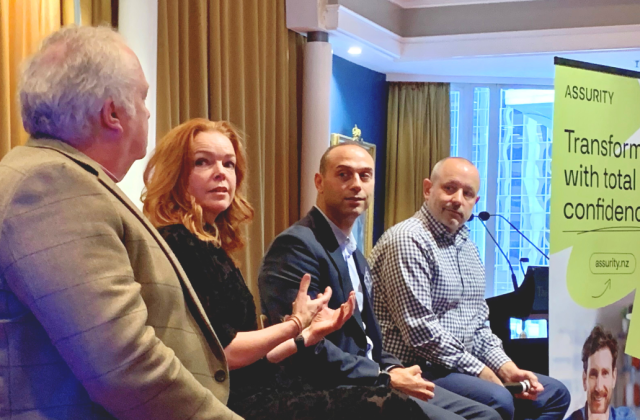Date: 11 October 2013
At 3.40am on a Wellington winter morning, I boarded a taxi shuttle bound for Wellington Airport. For the next 30 hours, I travelled. Over the Pacific Ocean, over the Date Line, over the equator. Eventually, at 9pm on a warm summer's evening, I reached the city of Madison, Wisconsin, exhausted but excited. I made my way to my hotel and discovered a group of other software testers congregating cheerfully in the hotel lobby. Within an hour-and-a-half of touching down, I found myself at the Great Dane Brewery, immersed in a world of other software testing enthusiasts from around the world.
It was the start of the Conference for the Association of Software Testing (CAST) 2013. We spent the rest of the evening talking testing, watching and taking part in dice games and engaging in lively debates. I could tell this would be an experience to remember.
I was 13,000 kilometres from my house, but I felt instantly at home.
So how did I get here? Well, I wasn’t at CAST 2013 just as an attendee. Nine months earlier, I had submitted a proposal for a presentation about an idea I had been practising that I really wanted to share. The proposal was accepted… and here I was.
My presentation was about using mind-mapping software as a testing tool to create visual testing models. I particularly wanted to demonstrate how it can facilitate learning, help with test idea generation and really aid with communicating the testing story.
Before going through this in Part 2 of this article, in Part 1 I’m going to cover my journey to seeking alternative ways to communicate my testing story. I’m going to talk about:
- What my values are as a tester
- What lean principles of software testing may look like, and
- How that informs my use of visual and lean models for communicating vs more traditional models of communication
My testing values
There are many different definitions of software testing and how you view the role of a tester informs what practices and artifacts you believe are valuable.
My preferred definition of software testing is from Cem Kaner: “Testing is an empirical investigation conducted to provide stakeholders with information about the quality of the product or service under test.”
Basically, we’re in the information-gathering and delivery business.
Furthermore, I identify as a context-driven tester. These are the seven principles of the context-driven school and this is my interpretation of them and what they mean to me:
“The value of any practice depends on its context” and “There are good practices in context, but there are no best practices.” Every testing problem is unique. How we approach each testing problem is therefore unique. So learning as much as possible and communicating your understanding of what you think the problem is, is vital to performing effective testing. My choice in tools reflects this belief. I like tools that are adaptable and give me freedom. The more adaptable and less rigid the tool or process is, the more contexts I can use it in.
“People working together are the most important part of any project’s context.” Knowledge exists in people’s heads. It doesn’t exist in the world in specifications or emails. Those are merely representations of knowledge. On a project, everyone has little pieces of the puzzle and no one person knows everything. Any practice that enhances social interaction – and any tool that helps me to communicate clearly what I think is going on – is a Good Thing™.
“Projects unfold over time in ways that are often not predictable.” Unfortunately, we can’t schedule all our insights at the beginning of the project. Things change. At any given point in time, we must be willing to throw away everything we believed to be true and change tack. If we acknowledge that early on, then we can be vigilant about keeping the cost of changing and discarding to a minimum.
“The product is a solution. If the problem isn’t solved, the product doesn’t work.” This, to me, is all about really understanding the purpose of what we’re testing and about seeing the whole. Software systems as a whole are greater than the sum of their parts. Every individual written requirement may be met, every user story may have passed a set of automated checks but, taken as a whole system, the software may completely fail to achieve what it was designed to do – or do it in less than ideal ways. Other emergent defects can occur when the software system is taken as a whole. Workflow inefficiencies, for example, often only become apparent when the entire system is viewed as whole.
“Good software testing is a challenging intellectual process” and “Only through judgement and skill, exercised cooperatively throughout the entire project, are we able to do the right things at the right times to effectively test our products.” The last two principles state that good testing requires skill and judgement to adapt and learn. It sums up that, since things change and since each situation is unique, we can’t just take a canned procedure, apply it to interchangeable human cogs on a factory line and expect good results.
In conclusion, central to the context-driven mindset is the idea that software development projects are complex and that it is better to accept that, rather than try to control it away. When we’re developing software, we’re solving novel and unique problems. When things change, it means someone has learned something. Learning leads us to better outcomes, so we should embrace that.
We should try to mold our practices to our environment, rather than try to mold our environment to our practices.
So if the principles of Context-driven Testing describe the world in which we find ourselves and how we ought to think about that world, are there any principles that describe how we should operate in those environments?
Lean testing
About a year ago, I encountered the principles of lean software development by Mary and Tom Poppendieck based on the principles of lean manufacturing – and they really resonated with me. I’ve adapted them and applied them to testing and what they mean to me. If the principles of Context-driven Testing describe the world and how we view it, then I believe these principles of lean testing describe how we may respond to that world:
Eliminate waste: I consider waste to be anything that doesn’t add value or something that the cost of creation is hugely asymmetrical to the benefit derived. Software projects have a limited amount of time in which we have nearly an infinite number of things to test. It should be our goal to squeeze as much as we can from every minute we have.
Amplify learning: As mentioned, software projects are volatile environments where change is constant. Information comes to us non-linearly and different people on the team are exposed to different information at different times. When we learn or discover something new, we need to make this new information as visible as possible.
Regularly revise: We can’t schedule our moments of inspiration or schedule when new ideas occur to us. We are constantly learning, as are others on the project. We need to be able to adjust our outputs and actions with the changing landscape and, as the desires of the stakeholders change, so too should our test strategy. Be willing to throw out everything I believed thus far.
Rapidly respond: Our role is to provide information to stakeholders to allow them to make quality-related decisions. Giving them information sooner allows them to make decisions sooner. Finding important bugs quickly allows them to be fixed in a timely manner. It aids with our credibility too. If someone taps us on the shoulder and asks “How did the testing go on the search module last week?”, we want to be able to give them a satisfactory answer quickly.
Collaborate and communicate: We don’t operate in a vacuum and I try to communicate what I’m doing and how I did it with anyone who’s interested. This is essential for maintaining transparency and trust. Speaking of which…
Maintain transparency and trust: Our greatest asset for getting things done and being able to do our jobs to the best of our ability, is trust. A lot of testing theatre and wasteful activities are undertaken in environments with little trust to avoid penalties or criticism. I also believe in meaningful reporting. A lot of the time, when someone is asking you for metrics or status reports in particular formats, it’s the only way they really know how to ask “What’s going on?”. I try to keep everyone in the loop as much as possible. It also means that rather than giving a ‘pass / fail’, I try to pass on as much information as possible about how I tested it and why I think a bug may exist or not. This means that any errors in my thinking or reasoning can be picked up by others. An environment of trust allows me to be transparent and being transparent builds trust.
See the whole: This is about staying mindful of the problem the software is trying to solve and for constantly questioning the context in which the product you’re testing fits in with the values of the customers and other stakeholders.
To sum up, I want to be able to give and receive as much information as I can in the limited amount of time I have and communicate it in a way that is respectful of others’ time and resources. These are my values and what I think constitutes responsible testing. However, the two biggest threats to these values as I see it, are the prevalence of premature test scripting and the overuse of IEEE829-style documentation. I have seen the overuse of these two practices undermine good testing and good communication.
IEEE829-style documentation and premature test scripting
When I talk about IEEE829-style documentation, I mean any style of documentation that is overly wordy, template-driven or ceremonial in nature.
I’m not saying there isn’t a time and place for these. Sometimes this style of documentation is necessary and useful, but the very beginning of a project when we know less than we will ever know again, when we have so much learning to do, is rarely the time or place. This style of documentation is a poor medium to communicate evolving understandings.
At worst, this style of documentation is often template-based and acts as a ceremonial deliverable to satisfy some checkbox.
But even at best, developing them requires a lot of time and effort and reading them and assimilating the information requires a lot of time and cognitive energy because any useful information is obfuscated within multi-thousand-word documents. It is difficult to extract the meaningful from the insignificant. How often do we see documents like this get written, signed off and then forgotten about on a shared drive, collecting virtual cobwebs?
To me, useful documentation is documentation that reflects my current understanding of the project in a format that makes it easy for me and others to retrieve that knowledge.
All in all, to crystallise our ideas so early when the cost of creation, editing and retrieval is so high and we still have so much to learn, makes little sense.
With regards to premature test scripting, I certainly favour a more exploratory approach to testing. My argument against scripting too early is:
1) At the beginning of a project, we know least about the project
2) Skilled exploratory testers perform hundreds of what could be considered discrete tests in a session. Few are worth repeating
3) Most tests performed are informed by the results of the previous test
4) The usefulness of a test is often not known until it has been performed. You don’t know if a rock is worth lifting until you’ve lifted it to see what’s underneath
5) Testers, when following a script, will deviate from the script
6) Different testers interpret scripted instructions differently resulting in differences between testers, even when following the same script
Therefore:
7) Test scripts don’t tell you what you may think they are telling you
Let’s revisit the principles of lean testing I proposed and see how the two practices of test scripting and traditional heavy documentation creation stack up:
Eliminate waste: Creating test scripts and large testing documents is a very labour-intensive job. Time spent writing documentation is time not spent testing. Investing large amounts of time and resources upfront on artifacts that are likely to become obsolete is wasteful.
Amplify learning: Because information comes to us non-linearly and at unscheduled times throughout a project’s lifetime, it doesn’t make sense to crystallise information early on in a format that is difficult to edit and difficult to retrieve information from.
Regularly revise: As mentioned, it’s important to always be willing and able to change our course and throw away what we previously believed to be true. Test scripts and traditional test documents are very difficult to edit and, based on the time spent creating them, it can be very painful to throw them away and start again based on new information. The linear format of a document makes revision difficult and test scripts by their nature do not allow flexibility in their execution.
Rapidly respond: When someone asks us how our testing is going, what we intend to test and what we’ve done so far, we want to give a quick response. Retrieval of information should be rapid. Also, if an issue arises or a fix for a defect is delivered, it is important that we have the ability to retest quickly and report our results efficiently. When testing and we discover that the map and the territory differ, our ability to be flexible and respond to that is important.
Collaborate and communicate and maintain transparency and trust: Lengthy word documents and detailed test scripts obfuscate valuable information. Reading a document requires an investment of time and energy. This often means that our day-to-day activities are hidden and our mental model of the testing problem is hidden too. Traditional test scripting and reporting also hinders communication and transparency. If a manager asks me “What was the greatest issue you discovered in the last week?”, it is less valuable to say “Well, our pass to fail ratio is 89.5%” than to be able to quickly tell a story about the system under test, how you tested it and what you discovered about it. If I am to collaborate and communicate on a daily basis in a way that is rich and honest, I need a way to do so that requires little effort on the part of my audience.
So where to next?
If it’s time to move on from premature test scripting and large cumbersome test documents, then how do we fill that gap? What do we do instead?
Instead, let’s delve a little deeper into what’s being asked of us when others request test scripts and test documentation. Could it be that that’s the only artifact they know of that will deliver what it is they want? What do people want? People want to know what you did, what your coverage model is and what you intend to do next.
In Part 2, I’ll describe an alternative that still gives stakeholders the information they require, but in a format that is more accessible and leaner.
I’ll outline the three pillars of a leaner testing approach: James Bach’s Heuristic Test Strategy Model at the strategy level, combined with James and Jonathan Bach’s Session and Thread-based Management as a framework for structuring and reporting our test execution, all communicated visually using mind-mapping software. I will then go through an example demonstrating how it all fits together.













